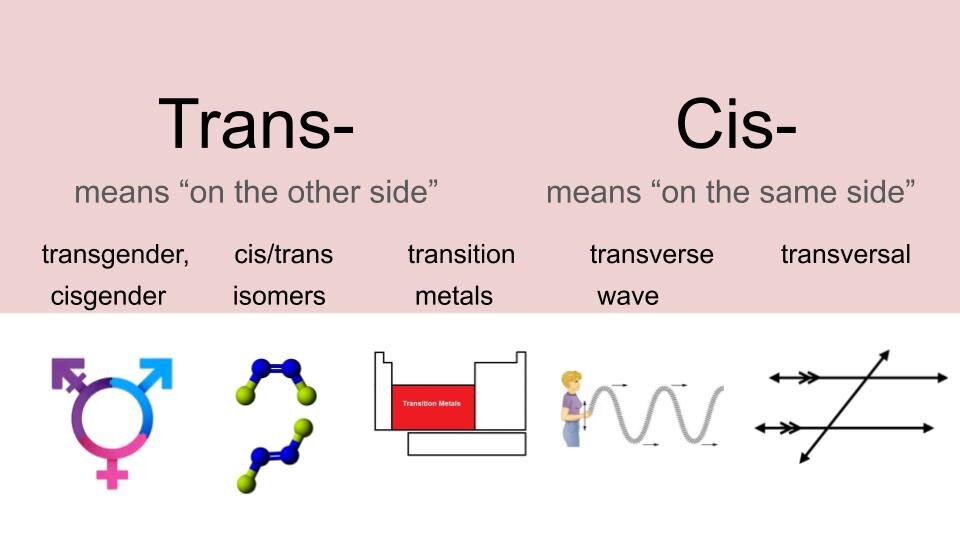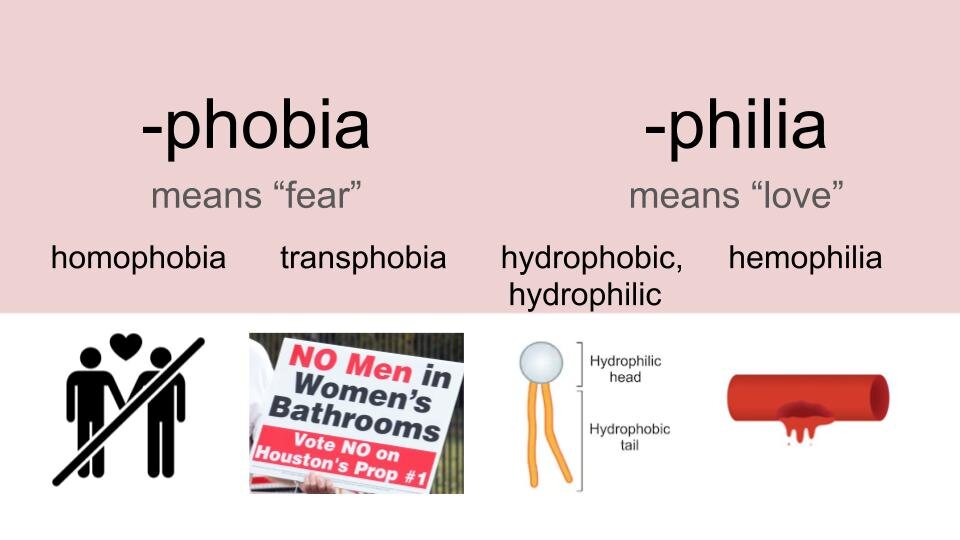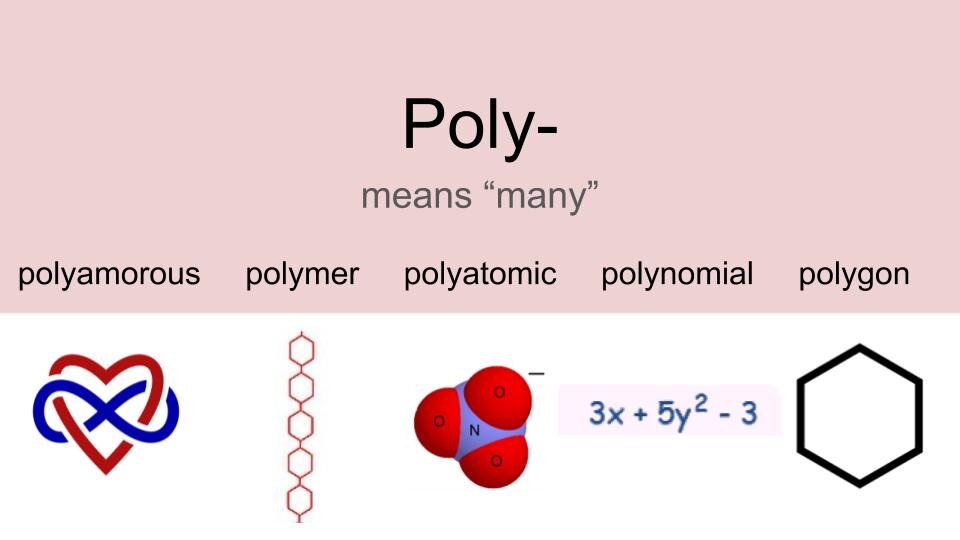In this Ph.D. dissertation, M. H. Hoelscher, discusses findings on possibilities for LGBTQ inclusion in life science educator preparation programs. Hoelscher suggests ways to integrate LGBTQ topics in many areas of biology curriculum, and reports on a multiple-case study of how science teacher candidates adopt LGBTQ inclusion.
The Egg and the Sperm: How Science Has Constructed a Romance Based on Stereotypical Male-Female Roles
The false romance of egg and sperm
In this article, anthropologist Emily Martin analyzes the metaphors that are used to teach reproduction and makes the claim that these metaphors reflect the socially constructed definitions of male and female.
Martin highlights modern research that dispels stereotypes of the sperm as being more aggressive, remarkable, and valuable than the egg. She advises scientists and educators to be aware of biases in the metaphors we use to describe human sex cells.
LGBTQIA Science/STEM Etymology
This is a partial list of root words that occur in both LGBTQIA issues and STEM content. Each root word has its own poster. This is a tool to help teachers integrate gender-inclusive themes into their teaching.
You might ask students to speculate on the meaning of a new science word like “homozygous” based on the meaning of the familiar word “homosexual”. Or you might have students write formal definitions of “transgender” and “cisgender” to apply their vocabulary after a lesson on cis- and trans-isomers. By taking a quick moment to make the connection, you can improve student literacy and affirm diverse identities in your classroom.
Diversity Is What Makes It Interesting To Study Living Things - in Rethinking Schools
Diversity Is What Makes It Interesting To Study Living Things
In this article from Rethinking Schools, I recount a few instances of gender-inclusive teaching in my genetics unit, and how students responded.
Caption: An illustration of a man with dark hair standing in front of a classroom of students. In the foreground, a student with dark skin and hair with purple streaks in it is sitting and raising a hand. The speech bubble rising shows two conjoined circles filled with a rainbow spectrum. The speech bubble rising from the man shows a black circle separated by a slash from a white circle, followed by a question mark.
Activity: Nondisjunction and Intersex Traits
Description
In this activity, students pick up the nuts and bolts of nondisjunction by playing the Meiosis Game created by Sara Freeman and Matt Gilbert. Students simulate two scenarios of nondisjunction and record information about the intersex traits that arise. Students learn that while 46,XX and 46,XY are the most common human karyotypes, there are many other viable and naturally occurring variations. Then students evaluate the merits and limitations of the model.
Student Work Samples
Student Worksheet
Teacher Moves: "But what do I say?" Responses to Gender Questions
Check out this selection of teacher responses to possible put-downs or questions about gender. The main rule of thumb is to be affirming and respectful of a preference or viewpoint while maintaining a safe space for emotional and intellectual challenge. Easy, right? /sarcasm
Link: http://www.welcomingschools.org/pages/be-prepared-for-questions-and-put-downs-about-gender/
Excerpt:
Question: “But he’s a boy, why does he dress like a girl?”
Response(s): “There are lots of different ways that boys can dress and lots of different ways that girls can dress. There are lots of ways that people of any gender can dress. All of these things are OK in our school. Those are the kinds of clothes that he likes to wear? What kinds of clothes do you like to wear?”
Question: “You overhear a student call another student who identifies as a boy, a “girl” in an insulting way.
Response(s): “That’s not OK at our school to call someone a “girl” to insult them or make them feel bad. We don’t use gender as a put-down.”
Gender-inclusion in classrooms "increase[s] students’ ability to empathize with others and embrace many forms of diversity" (Ching and Xu, 2017)
About 0.7% - 2.7% identify as transgender at high school age (Williams Institute, 2017) (Rider et al, 2018)
“LGBTQ students experience depression at higher rates than general population, negatively influencing success in college & higher rates of attempted or actual suicide.” (Pediatrics 2011)
“Nationally, LGBTQ students experience depression at higher rates than the general population, which negatively influences success in college (1) or worse, higher rates of attempted or actual suicide. Students who come out to their guardians may also lose financial support, jeopardizing persistence toward a degree. (2) Because we are a Catholic university, we recognize the inherent human dignity of all of our students and, as a result, are obligated to support their success. This is as true of our LGTBQ students as any other cohort. We know, however, that LGBTQ students often face unique challenges, including struggling to negotiate their sexual orientation and/or gender identity with their faith development. (3)”
— Rio et al. (2016) University of San Diego 2015-2016 LGBTQ Student Success Survey, available at https://www.sandiego.edu/inclusion/documents/2015-16%20LGBT%20Student%20Success%20Study%20FINAL.pdf.
Citing:
Hatzenbuehler, M. L. (2011). The social environment and suicide attempts in lesbian, gay, and bisexual youth. Pediatrics, 127(5), 896-903; Schmidt, C. K., Miles, J. R., & Welsh, A. C. (2010). Perceived discrimination and social support: The influences on career development and college adjustment of LGBT college students. Journal of Career Development, 0894845310372615. Paul, J. P., et al (2002). Suicide attempts among gay and bisexual men: lifetime prevalence and antecedents. American Journal of Public Health, 92(8), 1338-1345.
Higa, D. et al (2014). Negative and positive factors associated with the well-being of Lesbian, Gay, Bisexual, Transgender, Queer, and Questioning (LGBTQ) youth. Youth & Society 46(5), 663-687.
Gattis, M. N., Woodford, M. R., & Han, Y. (2014). Discrimination and depressive symptoms among sexual minority youth: Is gay-affirming religious affiliation a protective factor? Arch Sex Behav 43, 1589- 1599.
"A growing number of colleges and universities have been asking students to identify their gender identity and sexual orientation on admissions forms." (INSIGHT into Diversity 2016)
“In the last decade, a growing number of colleges and universities have been asking students to identify their gender identity and sexual orientation on admissions forms, either by adding a question to their own application or by adding a supplemental question to the Common Application. These institutions include Dartmouth College, Duke University, Elmhurst College, Elon University, Massachusetts Institute of Technology, Northeastern Illinois University, The Ohio State University, Purdue University, University of Iowa, University of Maryland, University of Rochester, and all two-year colleges in California and Washington. In addition, the Cooperative Institutional Research Program (CIRP), the most comprehensive source of information on college students, has also begun to ask questions about sexual orientation and gender identity.”
Evolution's Rainbow: A queer species database of 200+ organisms
Need a research Topic for queerness in living organisms?
Check out the 🔎SPECIES DATABASE from Stanford biologist Joan Roughgarden’s book, EVOLUTION’S RAINBOW (University of California Press). Click the link above, or check out the embedded document below for 200+ species from the asexual, gay, lesbian, transgender, intersex, and hermaphrodite spectra. Includes behavior, neurobiology, and chromosomal phenomena.
Editor’s note: The term "hermaphrodite" is appropriate for referring to non-human animals with sex characteristics that do not fit typical binary notions of male or female bodies. For humans, “intersex” is the appropriate term—learn more here!
"Young people and adults who adhere to rigid gender stereotyping and notions of masculinity are more likely to experience and commit sexual harassment and dating violence.” (Promundo 2018)
“When men believe that they are not – or are not perceived to be – “masculine” or “man enough,” they may use intimate partner violence as a way to overcompensate or conform with gendered expectations (Moore and Stuart 2005; Reidy et al. 2014). This dynamic is sometimes called “masculine discrepancy stress” or “gender role stress,” and it may be linked to multiple forms of violence.
A study in India (Krishnan et al. 2010) found that women were more likely to experience intimate partner violence if their husbands’ job stability decreased. A threat to a man’s status as a breadwinner might represent a threat to his masculine identity and thus could prompt violence as a way to regain social status and maintain power structures in the home, particularly if his wife was more securely employed.”
“Multiple studies confirm that rigid norms regarding gender, gender roles, family, and marriage – together with men’s childhood experiences of violence – contribute to men’s use of violence against female partners (Heise 2011; Moore and Stuart 2005; Levtov et al. 2014).
When men adhere more strongly to rigid, inequitable definitions of masculinity, they are more likely to also report perpetrating many forms of intimate partner violence (Barker et al. 2011; Levtov et al. 2014; Fleming et al. 2015).
In some settings, specific norms establish violence as an acceptable gender expression and problem-solving strategy for men, as well as social acceptance of intimate partner violence as a normal part of intimate relationships (Heise 2011).
In many contexts, a man’s use of violence against his wife as a way to control her behavior and reinforce
power structures implicitly or explicitly confers greater social status.”
The study describes comprehensive programs and multiple examples of ways to engage people of all genders in discussions about how traditional gender norms and gender non-conformity are connected with perpetration and experiences of bullying. Initiatives aimed at providing participants with a safe place to practice nonviolent, healthier ways to navigate peer groups and social dynamics incorporate gender-transformative methods to reshape the ways young people negotiate status and gender how they treat others.
Citation
Heilman, B. with Barker, G. (2018). Masculine Norms and Violence: Making the Connections. Washington, DC: Promundo-US. Available at https://promundoglobal.org/wp-content/uploads/2018/04/Masculine-Norms-and-Violence-Making-the-Connection-20180424.pdf.
“Receiving [information to counter gender stereotyping] at an early age is critical; there has been a steady decline in the average age at which puberty begins..." (NYT & PNAS 2015)
“Receiving [information designed to counter gender stereotyping] at an early age is critical. There has been a steady decline in the average age at which puberty begins. Among those assigned female at birth, some breast development by age seven and eight is no longer an anomaly. The age of the onset of puberty has also fallen for those assigned male at birth, from an average of age 11 to 10.5.”
Tabuchi, H. (2015) “Sweeping Away Gender-Specific Toys and Labels” The New York Times. Retrieved on January 23, 2019 from https://www.nytimes.com/2015/10/28/ business/sweeping-away-gender-specific-toys-and-labels.html
Joel, D et al. (2015) “Sex beyond the genitalia: The human brain mosaic.” Proceedings of the National Academy of Sciences. Dec 2015, 112 (50) 15468-15473
“Numerous studies found that beliefs in narrowly defined constructs of masculinity are associated with decreased well-being in intimate relationships.” (American Academy of Pediatrics 2018)
“Numerous studies have found that beliefs in narrowly defined constructs of masculinity are associated with decreased well-being in intimate relationships.”
Rafferty, J. (2018) Gender Identity Development in Children. American Academy of Pediatrics. Retrieved on January 14, 2019 from https://www.healthychildren.org/English/ages-stages/gradeschool/Pages/Gender-Identity-and-Gender-Confusion-In-Children.aspx, updated 5/11/22.
“[Of 45,689 papers, those] written by ethnically diverse groups were cited 11.2% more than were papers written by non-diverse groups.” (Nature 2018)
““Being inclusive gives research groups a competitive edge. It also happens to be the right thing to do...[Researchers matched 45,689 papers and found that,] all other factors being equal, the papers written by ethnically diverse groups were cited 11.2% more than were papers written by non-diverse groups.””
Powell, K. (2018) These labs are remarkably diverse — here’s why they’re winning at science, Nature 558, 19-22. doi: 10.1038/d41586-018-05316-5.
“LGBQ college students are 7% less likely than heterosexuals to persist in STEM after 4 years versus switching to a non-STEM field.” (Science Advances 2018)
“LGBQ college students are 7% less likely than heterosexuals to persist in STEM after 4 years versus switching to a non-STEM field.”
Hughes, B. (2018) Coming out in STEM: Factors affecting retention of sexual minority STEM students. Science Advances: Vol. 4, no. 3, eaao6373. DOI: 10.1126/sciadv.aao6373.
Holiday Prep, Pronoun Practice, & Recent Media [Nov]
Holiday preparations, pronoun practice, and more!
Read moreResource roundup: etymology, intersex traits, centering indigenous voices [Oct]
Hello, educators!
First off, a warm welcome to everyone who has recently joined our list. We're glad you are here! If you are interested in joining our interactive listserv to ask and answer questions from other educators, follow this link to sign up.
This month's newsletter highlights some more resources that you might find useful in your classroom.
Etymology stems - This awesome guide set up by Sam Long connects the etymology of words in science to terms common in the LGBTQIA+ community. From Sam: "This year my students are very interested in word origins and why things are named the way they are. I made this partial list of root words that occur in both LGBTQIA issues and science. It is a tool to help science teachers integrate gender-inclusive themes into their teaching. It's a pretty low-lift way to blend gender diversity into a science class. Please share your thoughts and additions!" Feel free to contact him with feedback and ideas - Sam.Long.MT@gmail.com.
October 26th was Intersex Awareness Day, celebrated in honor of the first known public demonstration by intersex advocates against nonconsensual genital surgeries in 1996. Read more about the history and impact of this day at InterACT and GLAAD, or read 9 ways intersex youth want to be supported by grown-ups to better-support intersex youth in schools.
Meiosis and Intersex Traits - Teaching meiosis and/or intersex traits at a high school or college level? Matt Gilbert's Sex Chromosome Meiosis Game explores the origins of some intersex traits in a way that is clear and interactive. This can also be a good way for educators to review processes that occur during meiosis in preparation for teaching intersex traits.
Two-Spirit Identity and centering Indigenous voices - Thanksgiving is coming up in the U.S., and there are lots of great resources about centering racial justice and indigenous rights in discussions of Thanksgiving. Some folks might not know that there are many examples of gender diversity being honored and respected in North American indigenous cultures. Though the terms and roles in different cultures vary, the term Two-Spirit became a universal term for gender diverse Indigenous North American people in the 1990s. Read more about the history the term Two-Spirit at the Indian Health Service or Indian Country Today, or watch a video about Two-Spirit and indigenous identity at them. magazine. You can also find books for your age group centering two-spirit stories - consider 47,000 Beads by Koja Adeyoha for young readers or Love Beyond Body, Space and Time for a young adult audience.
Conferences - If you're in the Denver area, look for Sam & Lewis at the Colorado Science Conference on Friday, November 8th.
Take care, all, and happy Halloween!
Lewis & Sam
Colorado Science Conference - Presentation Materials
We had a great time connecting with science educators at the 2019 Colorado Science Conference. Thank you for your interest in doing the work and blazing the trail for gender-inclusive biology.
Guidelines, Bio-Inclusive Examples, & Language Checklist [Sept]
Greetings, friends!
For those who are in the classroom at the start of a new school year, I hope that your year is off to an awesome start. Regardless, here's to the beginning of a new season.
In the September edition of the Growing a Gender-Inclusive Biology Education newsletter, we are sending out a few great resources that can serve to support the work you are doing in the classroom.
This Framework Article written by Sam Long details the principles of the gender-inclusive biology framework that we have been sharing at conferences around the country. Check it out and let us know if you have feedback! We will be sharing our work at several conferences this fall, including the NEA LGBTQ+ Issues Conference (October 11-13, Las Vegas, NV), Northwest Teaching for Social Justice (October 19, Seattle, WA), and the Colorado Science Conference (Noveber 8, Denver, CO).
Project Biodiversify - This is a phenomenal collection of resources for science educators and students put together by Ash Zemenick, Marjorie Weber, Alex Webster, and Sarah Jones. It includes several detailed slide decks with presenter notes that provide concrete examples of what moving towards inclusive language and pedagogy in the biology classroom can look like, and a collection of scientist profiles from diverse intersectional identities. They even offer in-person workshops! Definitely explore the library and pass along this resource in your professional networks.
SextEd Inclusive Language Checklist - This is a resource that I share frequently with educators who want guidance on navigating inclusive language for bodies, family structures, and behaviors in the classroom. Even though it is sex ed specific, there are many ways that this can be thought of in a more universal light, and I think this list does a good job of asking questions and providing examples without trying to identify a long list of "good" and "bad" words (which, of course, would be out of date as soon as it was published!).
Want to be more involved in gender-inclusive biology curriculum? Click HERE to sign up to join in on our listserv, a discussion forum where people can share ideas, classroom resources, and ask questions in a group of educators doing similar work.
Happy trails,
Lewis & Sam

























